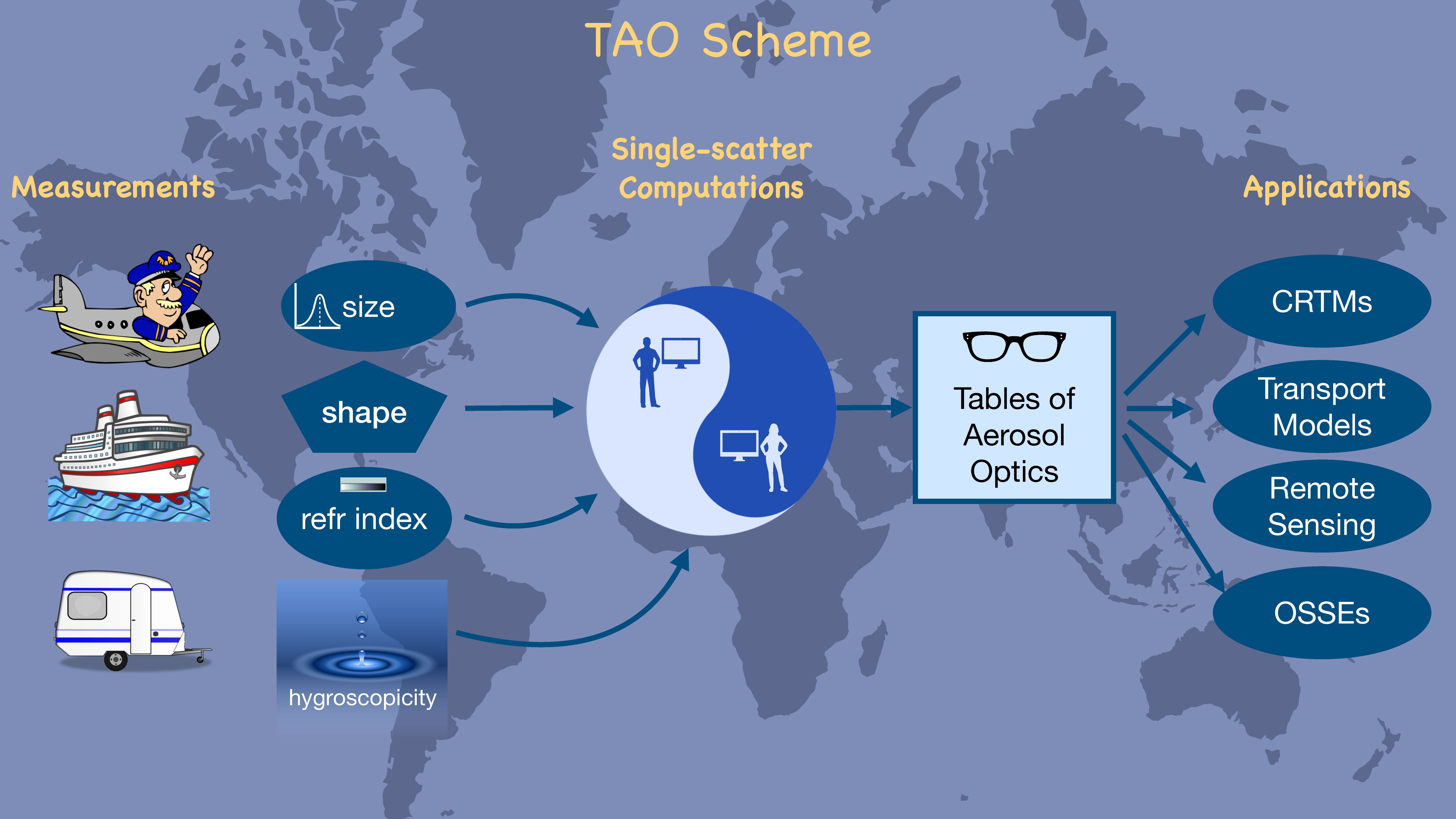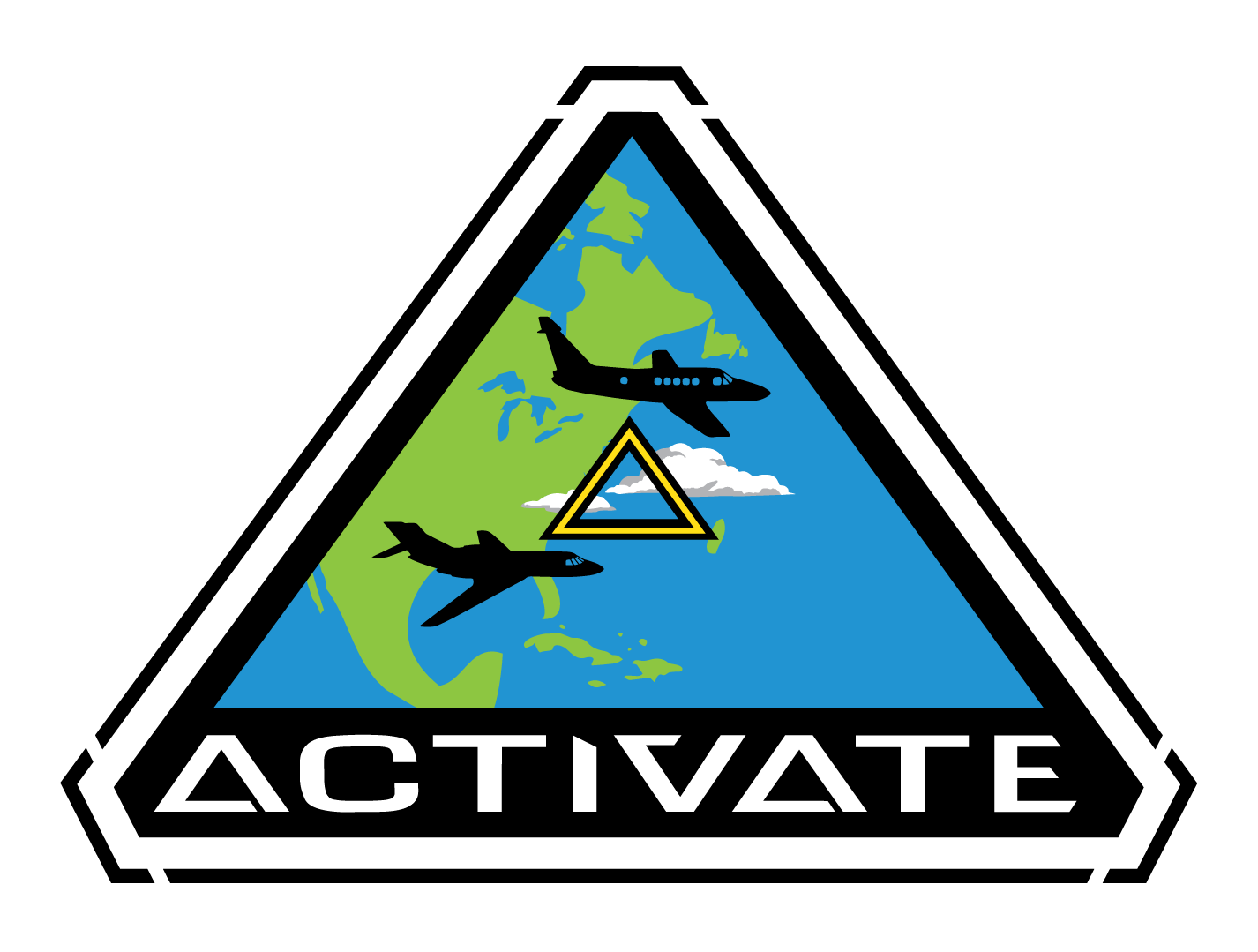Tables of Aerosol Optics
Overview
 The Table of Aerosol Optics (TAO) is a community repository of optics computations (extinction, absorption, single-scatter albedo, lidar ratio, etc) that are useful
for global models and remote sensing applications. TAO expands upon historical efforts (e.g., Shettle and Fenn, 1979; d’Almeida et al., 1991; Koepke et al., 1997; Hess et al., 1998)
by building an open database that uses recent measurements and new computational techniques for non-spherical particles. The ‘open’ aspect of TAO is important, since the size distributions,
refractive indices, and morphological recommendations of today will undoubtedly yield to different values in the future; the open framework of TAO allows scientists to keep
adding new computations to the database as the science evolves.
The Table of Aerosol Optics (TAO) is a community repository of optics computations (extinction, absorption, single-scatter albedo, lidar ratio, etc) that are useful
for global models and remote sensing applications. TAO expands upon historical efforts (e.g., Shettle and Fenn, 1979; d’Almeida et al., 1991; Koepke et al., 1997; Hess et al., 1998)
by building an open database that uses recent measurements and new computational techniques for non-spherical particles. The ‘open’ aspect of TAO is important, since the size distributions,
refractive indices, and morphological recommendations of today will undoubtedly yield to different values in the future; the open framework of TAO allows scientists to keep
adding new computations to the database as the science evolves.
Originally conceived by Arlindo da Silva, TAO is meant to be a community repository where specialists can put their computations for other scientists to use. So for instance, some groups are advancing new techniques that can accommodate complex fractal aggregates of black carbon, while other groups are working on realistic irregular shapes for mineral dust. The TAO database gives these scientists a place to distribute their products. As TAO grows, modelers and remote sensing specialists will look to TAO as a place to find a wide variety of choices for testing.
Meanwhile, global modelers can also use TAO to lobby for new tables that accommodate their needs. For instance, coarse particles like mineral dust and sea salt sediment at rates that depend upon size, so a single coarse mode does not fit well with their dynamic models. Consequently, the measured coarse mode needs to be divided into several smaller modes for the dynamics process, and these modes are later re-combined as external mixtures for the optical computations. Modelers need to make these needs known to the people who are computing the optical properties of dust and sea salt in order to fully leverage what TAO offers.
Eventually, TAO will provide mass extinction coefficients, mass absorption coefficients, lidar ratios, etc., at the OPAC wavelengths (0.25-40 µm; Hess et al., 1998) for all pertinent species (sulfate, sea salt, BC, OC, BrC, dust, etc.). TAO will also accept computations for aerosol ‘type’ (e.g., biomass burning, urban, background, etc.) that may include regional and seasonal variability. Separate tables are provided for common remote sensing wavelengths (AERONET, MISR, MODIS, POLDER, etc.). Multiple tables may be created for each species or type to account for the multiple valid size distributions and complex refractive indices that can be found in the literature.
At the present time, TAO is a highly fluid and loosely organized collection of optical tables that are available here. However, users should expect a bumpy ride until the TAO group becomes established — file format and existence may change quickly!
History
Modern aerosol tables were first compiled by Shettle and Fenn (1979), and this report represented a major step forward for the community at a time when Mie computations (and the computing power to run them) were not nearly as accessible as they are today. Since Shettle and Fenn (1979) is an Air Force report and such reports are not published in huge numbers, it was difficult for some scientists to find a copy. Thus, Shettle and Fenn (1979) was followed by d’Almeida et al. (1991), which is essentially a book version of Shettle and Fenn (1979). Releasing the tables to a private publisher in this way resulted in a much wider distribution of the tables than is generally achieved by a government press; here again, this was a major advancement for the scientific community. The next major step was the publication of Kopke et al. (1997) and Hess et al. (1998), both of which were accompanied by digital versions of the same aerosol optical tables that originated with Shettle and Fenn (1979). This was another major improvement over the previous state of affairs, as it enabled ready access for hundreds of scientists on the new World Wide Web of that day. The tables were later improved with Koepke et al. (2015), who re-computed the optical properties of the OPAC dust using spheroid shapes (instead of spheres) and added their results to the OPAC database.
TAO Activities
A Harmonized Simulation Platform (HSP) for MIRA
Linlu Mei, Vladimir Rozanov, Alexei Rozanov, John P. Burrows
Institute of Environmental Physics, University of Bremen
Models, in situ, and remote sensing tools aim to provide valuable information of aerosol loading and aerosol components/types on different levels
for a better understanding of aerosol effects on climate, weather and air quality. Intensive efforts have been made to understand the consistency
and difference of AOT inside individual community and between various communities. However, a gap for aerosol components & types in different communities exists.
In order to bridge such gaps and expand the overlap between aerosol specialties, new Tables of Aerosol Optics (TAO) and a harmonized simulation platform to understand the characteristics of TAO are urgently needed.
A harmonized simulation platform allows scientists to keep adding new aerosol database and make realistic simulations under different surface and atmospheric conditions.
SCIATRAN radiative transfer software package includes widely used aerosol databases from models (e.g. NASA MERRA), in situ (e.g. AERONET, OPAC),
and remote sensing (e.g. MODIS, MERIS) communities. New knowledge of aerosol science obtained in the framework of existing NASA MIRA projects will be seamlessly
included in SCIATRAN. Characteristics of new database & parameterization will be shared to MIRA community for the further developments.
Additionally, existing simulation platforms can be harmonized in SCIATRAN while further requirements for simulation platform can be achieved in the framework of MIRA.
We desire worldwide participation and collaborations in the following topics:
- How to understand the differences in aerosol optics under different assumptions for aerosol components & types from observation and modelling.
- How to apply new TAO to satellite retrievals and model simulations
- How to understand the impacts vertical and horizontal viabilities of aerosol optics on global aerosol datasets
References
d’Almeida, G., P. Koepke, and E. Shettle (1991), Atmospheric Aerosols: Global Climatology and Radiative Characteristics, A. Deepak. Hess, M., P. Koepke, and I. Schult (1998), Optical properties of aerosols and clouds: The software package OPAC, Bull. Am. Meteorol. Soc., 79 (5), 831–844. Koepke, P., J. Gasteiger, and M. Hess (2015), Technical Note: Optical properties of desert aerosol with non-spherical mineral particles: data incorporated to OPAC, Atmos. Chem. Phys.,doi:10.5194/acp-15-5947-2015. Koepke, P., M. Hess, I. Schult, and E. Shettle (1997), Global aerosol data set, Tech. Rep. 243, MPI Meteorologie Hamburg. L. Mei, V. Rozanov, A. Rozanov, and J. P. Burrows. SCIATRAN software package (V4.6): update and further development of aerosol, clouds, surface reflectance databases and models, Geosci. Model Dev. Discuss. [preprint], https://doi.org/10.5194/gmd-2022-153, in review, 2022. A. Rozanov, V. V. Rozanov, M. Buchwitz, A. Kokhanovsky, and J. P. Burrows. Sciatran 2 - a new radiative transfer model for geophysical applications in the 175 - 2400 nm spectral region: the pseudo-spherical version. Adv. Space Res., 36:1015–9, 2005. V. V. Rozanov, M. Buchwitz, K.-U. Eichmann, R. de Beek, and J. P. Burrows. Sciatran - a new radiative transfer model for geophysical applications in the 240 - 2400 nm spectral region: the pseudo-spherical version. Adv. Space Res., 29:1831–5, 2002 V. V. Rozanov, A. V. Rozanov, A. A. Kokhanovsky, and J. P. Burrows. Radiative transfer through terrestrial atmosphere and ocean: software package SCIATRAN. J. Quant. Spectr. Radiat. Transfer, 133:13–71, 2014. doi: 10.1016/j.jqsrt.2013.07.004. Shettle, E., and R. Fenn (1979), Models for the aerosols of the lower atmosphere and the effects of humidity on their optical properties, Tech. Rep. AFGL-TR-790214, Air Force Geophysics Laboratory.
Join the TAO distribution list at aerosol-optics-join@lists.nasa.gov and send an email to aerosol-optics@lists.nasa.gov if you would like to add your aerosol optical calculations to TAO

